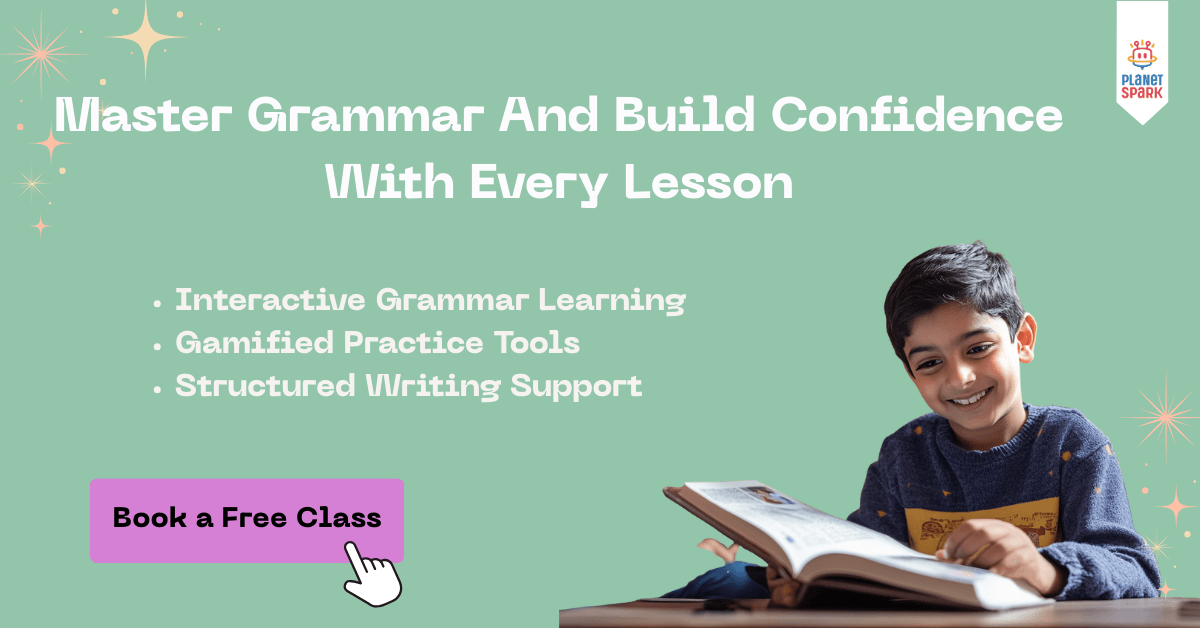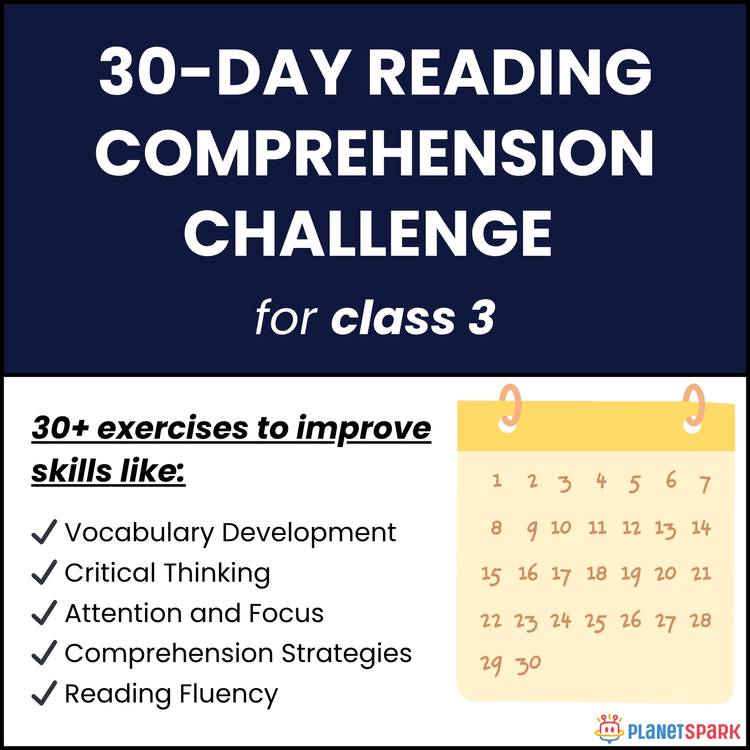Note-Making for Class 11: Examples, Tips, and Practice Passages

Table of Contents
- Tips for Effective Notemaking for Class 11
- CBSE Note-Making for Class 11 Format
- Note Making for Class 11: Format
- Note Making for Class 11: Example 1
- Note Making for Class 11: Example 2
- Note Making for Class 11: Example 3
- Common Mistakes in Note-Making for Class 11
- Points to Remember for Note-Making for Class 11
- Why Choose PlanetSpark for Note-Making Skills?
- Conclusion - Note Making for Class 11
- FAQs on Note-Making for Class 11
Class 11 marks the beginning of a crucial academic journey, where concepts become more detailed, chapters get longer, and exams demand deeper understanding. For many students, revising entire chapters before tests can feel overwhelming. This is where notemaking becomes a lifesaver.
In this blog, we will explore the importance of notemaking for Class 11, different types of notes, tips to create them efficiently, subject-wise examples, common mistakes to avoid, and strategies to make your study sessions more productive. By the end, you’ll be ready to take notes that make learning easier, faster, and more enjoyable.
Tips for Effective Notemaking for Class 11
Making effective notes is not just about writing down information, it’s about understanding, organizing, and retaining key concepts. Here are some practical tips to help Class 11 students create notes that really work:
1. Read and Understand First
Before you start writing, read the chapter thoroughly. Make sure you understand the main concepts and ideas. Notes are most useful when they reflect understanding, not just copied text.
2. Highlight Key Points
Identify important definitions, formulas, dates, and examples. Highlight or underline them in your book so you know what to include in your notes.
Boost your note-making skills today!
Book a free demo class with PlanetSpark and learn from expert teachers.
3. Use Headings and Subheadings
Organize your notes into clear sections. Use headings for main topics and subheadings for smaller points. This makes it easier to revise later.
4. Keep Notes Short and Concise
Avoid writing long paragraphs. Use bullet points, numbered lists, and short sentences to capture essential information.
5. Use Abbreviations and Symbols
Save time by using common abbreviations (e.g., “→” for leads to, “∆” for change) and symbols. Make sure you can understand them later.
6. Include Diagrams and Flowcharts
Visual aids like charts, diagrams, and flowcharts help in remembering complex concepts, especially for subjects like Biology, Chemistry, and History.
7. Color-code Your Notes
Using different colors for headings, formulas, and examples can make notes visually appealing and easier to memorize.
8. Revise Regularly
Notes are most effective when reviewed often. Schedule quick revisions after a day, a week, and before exams to reinforce memory.
9. Personalize Your Notes
Use examples, analogies, or mnemonics that make sense to you. Personalized notes are easier to remember than generic ones.
10. Keep Notes Neat and Organized
Messy notes can be confusing. Use a separate notebook or digital document for each subject, and keep pages organized for easy reference.
Pro Tip: Combining different types of notes, like bullet points, diagrams, and mind maps, can make your revision faster and more effective.

CBSE Note-Making for Class 11 Format
Taking notes is a method of organizing and summarizing information from multiple sources, making it easier to revise and remember key points. The following components form the standard note-making format for Class 11 students:
1. Title
The title of your notes should clearly reflect the main subject or topic. This helps you quickly identify the content during revision.
2. Source
Always mention the source of your notes, such as the textbook, article, or lecture. This is useful for reference later.
3. Current Date
Include the date when you are taking the notes. This helps track your progress and organize notes chronologically.
4. Titles & Subtitles
Use headings and subheadings to structure your notes. Breaking information into sections makes revision easier and more organized.
5. Use Bullets
Highlight key points using bullet points. Keep the language simple and direct. Focus on the most important ideas instead of copying everything.
6. Use Abbreviations
Abbreviations save time and space. For example:
“w/” for “with”
“b/c” for “because”
“∆” for “change”
Make sure you can easily understand your abbreviations later.
7. Highlight Important Points
Use highlighters or underlines to draw attention to critical information. This makes it easier to locate essential points during revision.
8. Use Diagrams / Visual Aids
Visual aids such as flowcharts, graphs, tables, and diagrams help you understand and remember complex information quickly.
9. Summarize
At the end of your notes, write a brief summary of the main ideas in a paragraph or two. This helps in quick revision and retention.
10. Review Regularly
Regularly review your notes to retain crucial information and reinforce learning. Frequent revisions ensure that the knowledge stays fresh in your memory.
Don’t wait!
Start learning note-making online with interactive CBSE-style passages and step-by-step guidance. Book Now!
Note Making for Class 11: Format
Title
Main Point 1
1.1 Subpoint 1
1.2 Subpoint 2
1.3 Subpoint 3
1.3.a Sub-subpoint 1
1.3.b Sub-subpoint 2Main Point 2
2.1 Subpoint 1
2.2 Subpoint 2
2.3 Subpoint 3
2.3.a Sub-subpoint 1
2.3.b Sub-subpoint 2
2.3.c Sub-subpoint 3Main Point 3
3.1 Subpoint 1
3.2 Subpoint 2
3.3 Subpoint 3Main Point 4
4.1 Subpoint 1
4.2 Subpoint 2
4.3.a Sub-subpoint 1
Note Making for Class 11: Example 1
Read the passage given below:
Passage:
The modern world is witnessing an unprecedented rate of urbanisation, with cities expanding at a pace that is faster than ever before. Urbanisation brings with it both opportunities and challenges. On the one hand, it stimulates economic growth, creates employment opportunities, and fosters innovation through the concentration of talent and resources. Cities often serve as cultural and educational hubs, offering better access to healthcare, education, and recreational facilities.
However, rapid urbanisation also leads to several problems. One of the most pressing issues is the strain on infrastructure, including transportation, water supply, electricity, and sanitation. Many cities struggle with traffic congestion, inadequate public transport systems, and a growing demand for housing, which drives up property prices and makes accommodation unaffordable for low-income families. Environmental concerns are also significant. The expansion of urban areas often results in the loss of green spaces, increased air and water pollution, and the urban heat island effect, which raises local temperatures and affects climate patterns.
Socially, urbanisation can create disparities in income and living standards. While some sections of society enjoy a high quality of life, others live in overcrowded slums with limited access to basic amenities. The influx of migrants seeking better opportunities can exacerbate social tensions and place pressure on public services. Crime rates may rise in rapidly growing cities due to unemployment, poverty, and inadequate policing.
Despite these challenges, cities remain engines of growth and development. Governments and urban planners are exploring sustainable urbanisation strategies to address these issues. Smart city initiatives, emphasis on renewable energy, improved public transport, waste management solutions, and inclusive urban policies are being implemented in many countries. Education and awareness campaigns aimed at responsible urban living are also crucial. By balancing economic growth with environmental conservation and social equity, cities can become more sustainable, inclusive, and livable for all residents.
Notes:
Title: Urbanisation: Opportunities and Challenges
Main Point 1: Benefits of Urbanisation
1.1 Economic growth and employment opportunities
1.2 Concentration of talent fostering innovation
1.3 Access to better facilities
1.3.a Healthcare
1.3.b Education and recreation
Main Point 2: Challenges of Urbanisation
2.1 Strain on infrastructure
2.2 Housing issues and unaffordability
2.3 Environmental concerns
2.3.a Loss of green spaces
2.3.b Air and water pollution
2.3.c Urban heat island effect
Main Point 3: Social Impacts
3.1 Income disparities
3.2 Overcrowding and slum conditions
3.3 Migration pressures and rise in crime
Main Point 4: Solutions and Sustainable Urbanisation
4.1 Smart city initiatives and renewable energy
4.2 Improved public transport and waste management
4.3.a Inclusive urban policies and education campaigns
Note Making for Class 11: Example 2
Read the passage given below:
Passage:
Climate change has emerged as one of the most critical global challenges of the 21st century. Rising temperatures, shifting weather patterns, and increasing frequency of extreme events such as cyclones, floods, droughts, and heatwaves are affecting ecosystems, economies, and human lives. The primary cause of climate change is the excessive release of greenhouse gases into the atmosphere due to human activities like burning fossil fuels, deforestation, and industrial processes. Carbon dioxide, methane, and nitrous oxide trap heat in the atmosphere, resulting in global warming.
The consequences of climate change are far-reaching. Glaciers and polar ice caps are melting, leading to rising sea levels and threatening coastal communities. Agricultural productivity is being affected due to unpredictable rainfall patterns and extreme weather events, which in turn can lead to food insecurity. Biodiversity is at risk, with many species unable to adapt to rapidly changing habitats. Human health is also impacted, as heatwaves, vector-borne diseases, and water scarcity increase.
Addressing climate change requires concerted global action. Governments, industries, and individuals must work together to reduce greenhouse gas emissions and adopt sustainable practices. Renewable energy sources like solar, wind, and hydroelectric power can replace fossil fuels. Afforestation and reforestation help absorb carbon dioxide, while energy efficiency and waste reduction minimize environmental footprints. International agreements such as the Paris Agreement provide frameworks for countries to set targets and collaborate on mitigation efforts. Public awareness and education campaigns are vital to encourage eco-friendly lifestyles.
Notes:
Title: Climate Change: Causes, Effects, and Solutions
Main Point 1: Causes of Climate Change
1.1 Excessive greenhouse gas emissions
1.2 Human activities
1.2.a Burning fossil fuels
1.2.b Deforestation
1.2.c Industrial processes
Main Point 2: Consequences of Climate Change
2.1 Rising temperatures and extreme weather
2.2 Melting glaciers and rising sea levels
2.3 Impact on agriculture and food security
2.3.a Unpredictable rainfall patterns
2.3.b Crop losses and food scarcity
2.3.c Threat to biodiversity
2.3.d Human health risks
Main Point 3: Solutions to Climate Change
3.1 Use of renewable energy
3.2 Afforestation and reforestation
3.3 Energy efficiency and waste reduction
3.3.a Adoption of eco-friendly technologies
Main Point 4: Global Cooperation and Awareness
4.1 International agreements (e.g., Paris Agreement)
4.2 Public awareness and education campaigns
Struggling with summarizing and organizing notes?
Join PlanetSpark’s personalized classes and master note-making easily.
Note Making for Class 11: Example 3
Read the passage given below:
Passage:
Digital technology has transformed every aspect of modern life, from communication and education to healthcare and commerce. The rise of smartphones, the internet, artificial intelligence, and cloud computing has created opportunities for efficiency, innovation, and global connectivity. Education has benefited enormously, with online learning platforms allowing students to access courses, resources, and expert guidance anytime and anywhere. Healthcare services now leverage telemedicine, digital records, and wearable devices to monitor and improve patient outcomes.
However, the digital revolution also presents challenges. Cybersecurity threats, including hacking, identity theft, and online fraud, are becoming increasingly common. Excessive screen time, social media addiction, and digital distractions can affect mental health, productivity, and interpersonal relationships. Digital inequality is another concern, as not all individuals or communities have equal access to technology, creating a gap in education, employment, and social opportunities. Ethical issues, such as data privacy, artificial intelligence bias, and misinformation, require careful regulation and awareness.
To maximize the benefits of digital technology while minimizing its risks, stakeholders must adopt responsible practices. Governments need to implement cybersecurity policies, data protection laws, and digital literacy programs. Schools and workplaces should encourage balanced technology use and promote critical thinking skills. Individuals must practice safe online behaviour, verify information, and manage screen time effectively. By embracing digital tools thoughtfully and ethically, society can harness technology’s potential to drive progress while safeguarding wellbeing and equity.
Notes:
Title: Digital Technology: Advantages, Challenges, and Responsible Use
Main Point 1: Advantages of Digital Technology
1.1 Transformation in communication, education, healthcare, and commerce
1.2 Education benefits
1.2.a Online learning platforms
1.2.b Access to resources and expert guidance
1.3 Healthcare improvements
1.3.a Telemedicine
1.3.b Digital records
1.3.c Wearable monitoring devices
Main Point 2: Challenges of Digital Technology
2.1 Cybersecurity threats
2.2 Mental health and addiction issues
2.3 Digital inequality
2.3.a Access to education and employment
2.3.b Social disparities
2.4 Ethical concerns
2.4.a Data privacy
2.4.b AI bias and misinformation
Main Point 3: Solutions and Responsible Use
3.1 Government policies and digital literacy
3.2 Balanced use in schools and workplaces
3.3 Individual responsibility
3.3.a Safe online behaviour
3.3.b Managing screen time
Main Point 4: Maximizing Potential
4.1 Thoughtful and ethical adoption of technology
4.2 Ensuring progress with equity and wellbeing
Common Mistakes in Note-Making for Class 11
Note-making is a vital skill for effective learning, but students often make avoidable errors that reduce its usefulness. Being aware of these common mistakes can help you prepare clearer, more organized notes.
1. Writing Everything Word-for-Word
Students sometimes copy sentences directly from the passage instead of summarising key points.
Tip: Focus on main ideas and use keywords or short phrases rather than full sentences.
2. Ignoring the Hierarchy of Points
Skipping proper numbering of main points, subpoints, and sub-subpoints can make notes confusing.
Tip: Follow the standard format with clear main points, subpoints, and sub-subpoints to maintain structure.
3. Using Long, Complicated Sentences
Writing lengthy sentences makes revision difficult and time-consuming.
Tip: Break ideas into concise phrases and simple sentences.
4. Omitting Important Details
Sometimes students capture only some points and miss critical information, weakening understanding.
Tip: Identify keywords and concepts before writing; ensure all major ideas are included.
5. Overloading Notes with Examples
Including too many examples can clutter the notes.
Tip: Use 1–2 essential examples per point to clarify the concept.
6. Poor Use of Abbreviations or Symbols
Random or inconsistent abbreviations can confuse later when revising.
Tip: Develop a consistent set of abbreviations and symbols and use them throughout.
7. Neglecting the Title and Source
Many students forget to add a descriptive title or mention the source, which reduces clarity and context.
Tip: Always start with a relevant title and note the source for reference.
8. Lack of Review and Revision
Notes that are written but never revised are less effective for learning.
Tip: Review notes soon after writing to ensure completeness and clarity.
Quick Tip: Effective note-making is about summarising intelligently, maintaining structure, and focusing on clarity. Avoid these mistakes to save time and boost exam preparation.
Get guidance from experienced teachers. Learn note-making and other essential skills with PlanetSpark.
Book Now!
Points to Remember for Note-Making for Class 11
Read the passage carefully
Understand the main idea and key points.
Identify the theme, topic sentences, and supporting details.
Identify the title
Choose a concise title reflecting the passage’s main subject.
Pick out main points and subpoints
Main points are the major ideas; subpoints support or explain them.
Use numbering and indentation for clarity.
Use abbreviations and symbols
Common abbreviations: “govt” for government, “edu” for education.
Symbols: → (leads to), ↑ (increase), ↓ (decrease), % (percent).
Keep it concise
Avoid copying full sentences; summarize ideas in your own words.
Maintain proper hierarchy
Main Point → Subpoint → Sub-subpoint (as per format).
Include examples if mentioned
Helps in understanding and remembering points.
Use clear language and keywords
Focus on nouns, verbs, and numbers; avoid unnecessary adjectives.
Underline or highlight key terms
Makes revision faster and easier.
Practice regularly
The more passages you summarise, the better your speed and accuracy.
Check for accuracy
Ensure you capture the main ideas without adding personal opinions unless required.
Time management
In exams, spend 5–7 minutes reading, 10–12 minutes writing notes for a passage of 300–350 words.

Why Choose PlanetSpark for Note-Making Skills?
Mastering note-making is not just about exam success; it’s about developing critical reading, summarizing, and analytical skills that help students excel in academics and beyond. At PlanetSpark, we make learning these skills interactive, engaging, and effective.
Personalized Learning
PlanetSpark’s online classes provide one-on-one attention, helping students identify their strengths and areas for improvement.
Lessons are tailored to the student’s learning pace, ensuring concepts like main points, subpoints, and abbreviations are mastered.
Interactive Practice
Students practice note-making with real CBSE-style passages, like those in previous years’ sample papers.
Teachers provide instant feedback, helping students refine their notes for clarity, accuracy, and conciseness.
Skill Integration
Note-making lessons are integrated with comprehension, summarizing, and writing skills, making learning holistic.
Students learn to extract key ideas, organize information hierarchically, and present it effectively, skills useful across subjects.
Exam-Ready Approach
Regular exercises, sample papers, and timed practice sessions help students perform confidently in exams.
Focus on format adherence, ensuring students are fully prepared for CBSE’s note-making pattern.
Boosts Academic Confidence
Beyond marks, students develop critical thinking, reading comprehension, and structured writing abilities.
This foundation helps in higher studies, competitive exams, and professional communication.
Conclusion - Note Making for Class 11
Note-making is a crucial skill for Class 11 students, helping them summarize information, organize ideas, and improve comprehension. By understanding the passage, identifying main points and subpoints, and using a structured format, students can make their notes concise, clear, and exam-ready. Regular practice with real CBSE-style passages, combined with guidance from platforms like PlanetSpark, ensures students not only perform well in exams but also develop lifelong learning skills like analytical thinking, effective writing, and quick revision.
FAQs on Note-Making for Class 11
Q1. What is note-making in Class 11?
A. Note-making is the process of summarizing a passage by identifying main points, subpoints, and supporting details in a structured format.
Q2. How is note-making different from summary writing?
A. While both involve condensing information, note-making focuses on hierarchical points (main points, subpoints, sub-subpoints), whereas a summary is written in continuous sentences.
Q3. How should I choose the title for note-making?
A. The title should be concise and reflect the passage’s main theme. It can be one or two words or a short phrase.
Q4. Can I use abbreviations in note-making?
A. Yes, using standard abbreviations and symbols helps save time, but they should be clear and understandable.
Q5. How much time should I spend on note-making in exams?
A. For a 300–350 word passage, 5–7 minutes for reading and 10–12 minutes for writing notes is ideal.
Q6. How can PlanetSpark help in improving note-making skills?
A. PlanetSpark provides personalized classes, interactive practice, expert guidance, and CBSE-style exercises, ensuring students master note-making efficiently.
Download Free Worksheets
Personalized Communication Report
Record a video to get a AI generated personalized communication report for your child

Hi There, want to try these
tips for your child with
LIVE with our expert coach?
Let's check your child's
English fluency

